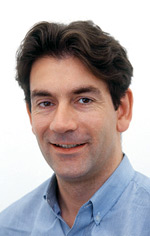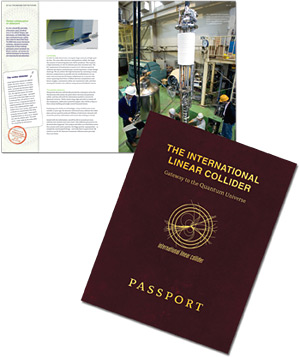Commentary: Philip Burrows
 |
| Photo courtesy of Philip Burrows |
An engaging new way to get the message out
In August, the International Linear Collider reached an important milestone when two huge documents were presented to the international particle physics community at a meeting in Daegu, Korea.
The Reference Design Report and Detector Concepts Report total four volumes and hundreds of pages. They describe, in scientific and technical detail, the potential for discovery with the ILC, the state of the design, and current thinking about how particle detectors could be laid out. More than 1500 scientists and engineers from around the globe contributed to the work that is documented in these reports. The detailed R&D, engineering, and design work comes together from many laboratories and universities around the world, all of them invested in making the ILC a reality.
Just as significant is a companion document presented at the same meeting of the International Committee on Future Accelerators in Daegu. A slender 38 pages, The International Linear Collider: Gateway to the Quantum Universe is less imposing. Prepared by a dedicated committee over the past one and a half years, it also documents the work of the global ILC team, but with less emphasis on the technical details. Thats because Gateway is intended primarily for an audience outside the particle physics community. It represents our attempt to distill the ILC science goals, the key features of the collider and detector designs, and the technological challenges, and put them in an accessible and easy-to-read format.

Gateway is written for government decision-makers, including elected representatives and administration officials who help set science policy; representatives of the businesses and industries that will ultimately produce the myriad components of the collider; scientists outside particle physics; educators at universities, colleges, and high schools; and interested members of the public, on whose behalf we are pursuing the physics of the Terascale.
Considering these audiences, and mindful of the fact that they live in a number of different countries, we have tried to make Gateway to the Quantum Universe attractive, approachable, and fun. Our hope is that readers can absorb the report in the time it takes to make a short journey by plane or train, aided by the many illustrations inside. We shall distribute copies this autumn through our international funding agencies, laboratories, universities, and national communities, and the document will also be presented via an attractive Web site.
Now that the Reference Design Report is finished, the ILC needs to change gears. We need to broaden our communications horizon beyond internal publicationssuch as ILC NewsLine, with its news, features, and weekly updatesto include a more diverse audience.
The assembly and honing of Gateway by 20 representatives of the global ILC community was the easy part. The next stage will require help from all of us who care about the future of particle physics.
We have an exciting science case and a compelling roadmap for the scientific journey that will lead us to uncover the mysteries of the Terascale. The first milestone will be the start of the Large Hadron Collider at CERN in 2008. We are all keen to see the discoveries that will surely be made there. The ILC will be our next major milestone, and we need to prepare for it and make it happen. We can all do our parts to engage with our local politicians, funding agencies, companies, colleagues, relatives, and friends. Make good use of Gateway to the Quantum Universe and help get the message out.
Philip Burrows is a professor in the John Adams Institute for Accelerator Science at Oxford University. He served as chair of the Gateway to the Quantum Universe committee.
Click here to download the pdf version of this article.


